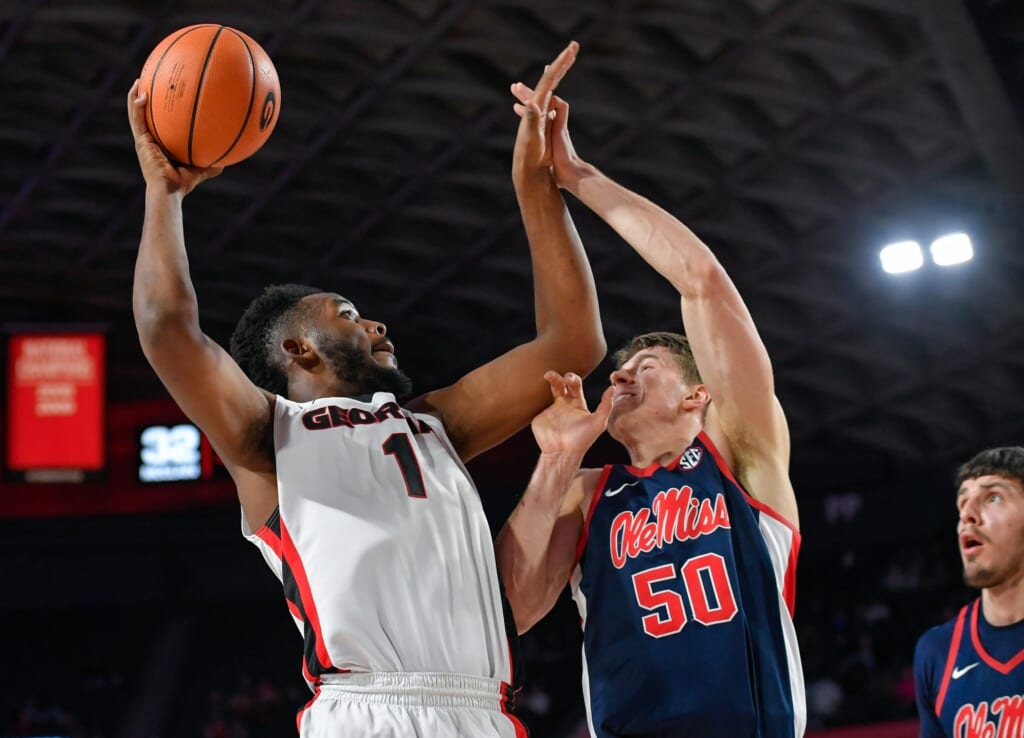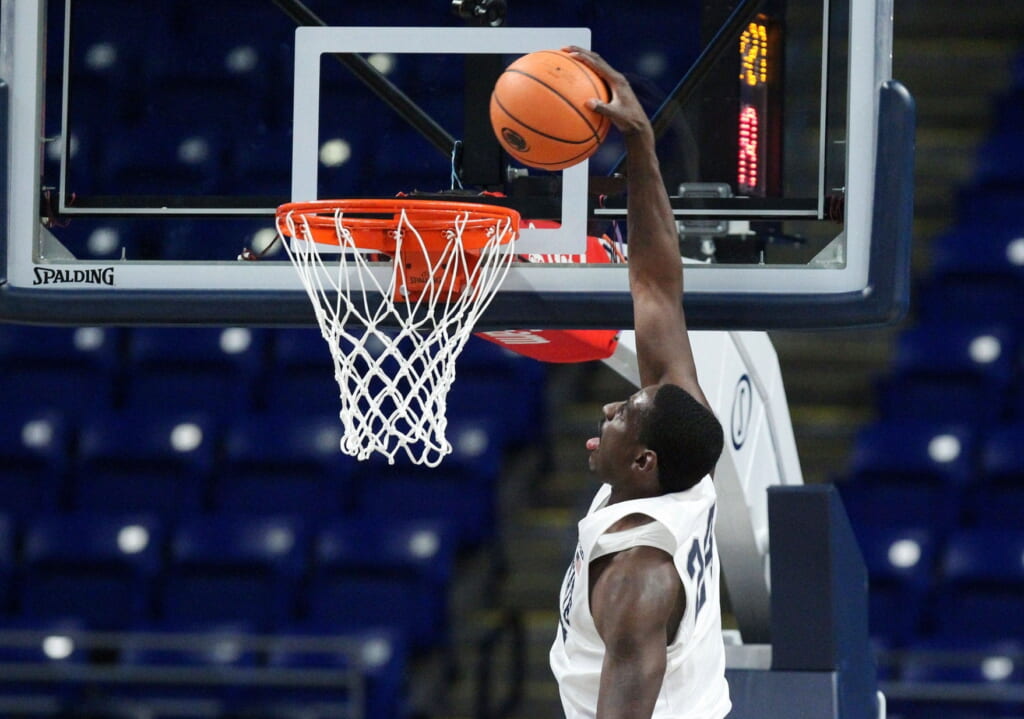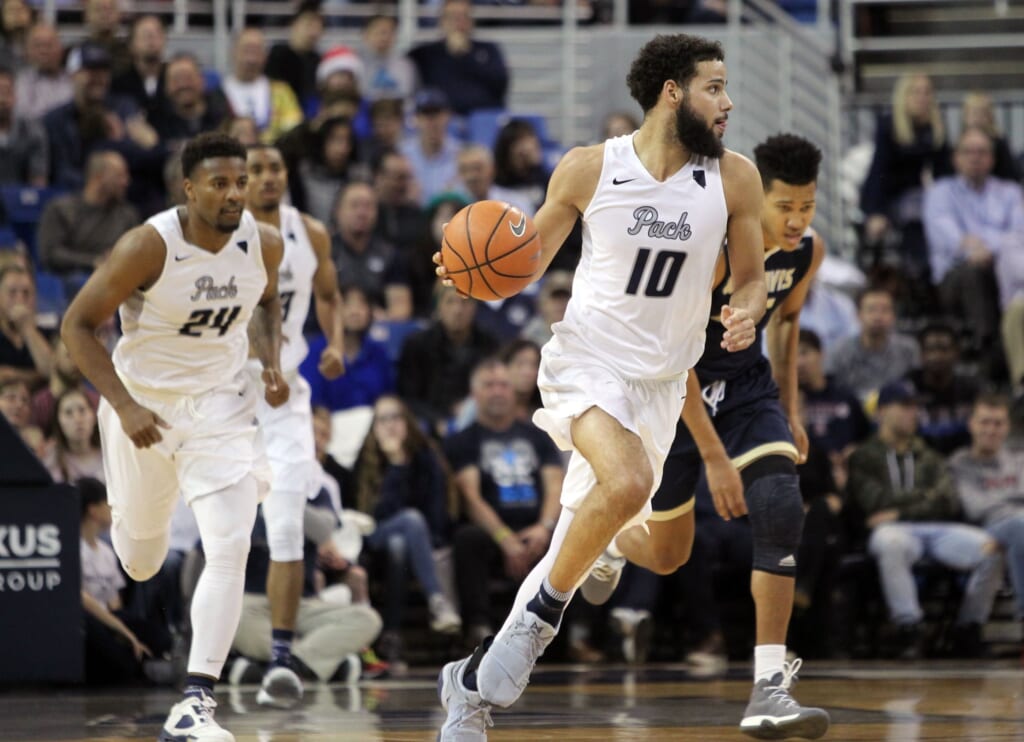
More than any other sport, it’s easy for a great college basketball player to slide off the radar. With 351 teams playing at the Division I level, such an event isn’t a phenomenon, but an inevitability. Even players on some of the nation’s best teams can go unnoticed because they play in smaller conferences — particularly those on the West Coast.
Here, we’ll try to bring some of those players to light. Next time you’re flipping channels on a Saturday, waiting for a player to catch your eye, it could well be one of these. Here are 14 of college basketball’s most underrated stars.
Jock Landale, Saint Mary’s
Hardcore college hoops fanns know Landale as one of the best players in the country — second only to Trae Young in KenPom’s Player of the Year rankings. More casual fans, however may not have seen St. Mary’s’ Australian center. Those in the latter group are missing out. Landale is putting up 21.7 points and 10.3 rebounds per game for the Gaels. He’s playing good defense and his 65.3 effective field goal percentage is 35th in the country, per KenPom. Right now, Landale is arguably the best big man in college basketball. He deserves more recognition.
Chandler Hutchison, Boise State
Hutchison is coming off his best performance of the year and, for that matter, one of the best single-game performances by anyone in the country. With the Broncos locked in a tight game with San Diego State — another Mountain West team on the bubble — Hutchison exploded. He went for 44 points on 8-of-11 shooting from inside the arc and 7-of-10 shooting from beyond it. He was 7-of-9 from the line, and threw in eight rebounds for the cherry on top. It’s unlikely we see a game like that from him again this year, but that’s his ceiling on a nightly basis. If you can’t find a game to your liking on a random Saturday, anything involving him is worth watching.
Yante Maten, Georgia

Maten, a senior power forward for the Bulldogs, is becoming a weapon of mass destruction. He’s up to 19.6 points and 8.9 rebounds per game — both career highs. His 14.2 offensive rebound rate is one of the best in the country and his 4.7 block percentage qualifies him as a strong rim protector. Maten has developed some range as well, hitting 37 percent from outside. He’s also surpassed his 2017 total for 3-point attempts already, becoming more willing to fire when teams leave him open. As Georgia looks to make a run in the SEC, Maten will be one to watch.
Kyron Cartwright, Providence
Cartwright isn’t the type who will blow you away scoring the basketball, but he is a boatload of fun to watch. Now a senior for the Friars, Cartwright is the type of point guard who runs the offense in a somewhat traditional way, but doesn’t necessarily need to do so. Most of his time is spent dishing to Rodney Bullock or Alpha Diallo — Cartwright’s 42.4 percent assist rate ranks sixth in the country, per KenPom — but overplay passing lanes and he’ll make you pay. Cartwright is a 46.2 percent shooter from deep and capable of creating his own offense if necessary. His presence alone usually makes Providence a worthy watch.
Jordan Bowden, Tennessee
It’s probably a stretch to call Bowden — a wing who scores just 10.9 points per game for the Vols — a star. But he’s heavily underrated nonetheless. For starters, Bowden is hitting 58.8 percent of his 3-pointers(!) and not for a lack of attempts. He’s no Trae Young, but Bowden is launching 3.2 triples per game and hitting a healthy majority. That alone deserves some recognition. He’s also defensive rebounding at a 10.5 percent clip — a healthy number for a wing — and has a +10.1 box plus-minus for Tennessee. Bowden is an impact player for the Vols right now and has all the makings of a star down the road.
Anfernee McLemore, Auburn
McLemore doesn’t jump out on a statsheet — he scores just 7.9 points per game in nearly 20 minutes. But the 6-foot-7 center is one of the best rim protectors in the country. McLemore’s 17.4 percent block rate is second only to Pacific’s Namdi Okonknwo, per KenPom. He also has a stupidly low 89.6 defensive rating, according to Sports Reference. That’s one heck of an impact for someone who’s used on just 16.9 percent of Auburn’s possessions, per KenPom. McLemore is a solid rebounder and efficient scorer, but the defensive side is where he makes a difference. Without him, the Tigers might be doomed to failure in the SEC.
Mike Watkins, Penn State

If you’re sensing a commonality here: big men tend to be under-appreciated. Watkins is no exception. The sophomore center ranks fifth in the country with a 31.1 percent defensive rebounding rate, per KenPom. Though he scores just 13.6 points per game, Watkins does so on a 70.4 effective field goal percentage. He also swats away over 10 percent of opposing shots, per KenPom, an all-around statistical profile good enough to compare with nearly any big man in the country. Penn State has been fairly disappointing this season, along with most of the Big Ten. Watkins has not.
Tyler Cook, Iowa
Cook’s national profile suffers from being the best player on a bad Iowa team, but we’ll take some time to talk about him here. Cook is quietly averaging a double-double — 23.2 points and 10.2 rebounds — on a per-40-minute basis right now. He’s getting to the free throw line over six times every game and scoring efficiently, with a 62.4 true shooting percentage. It ain’t pretty — for that matter, not much about Iowa basketball is — but Cook is getting things done in the Big Ten right now. He probably deserves a tad more attention than he’s been getting.
Udoka Azubuike, Kansas
When you throw a handful of the best players in the country onto one team, one of them is going to fly under the radar. In the case of the Jayhawks, that someone is Azubuike, a 7-footer who leads the country with a 78.1 effective field goal percentage. Sure, almost none of those shots are from outside the paint, but that doesn’t make a difference if you’re scoring 23.1 points per 40 minutes. Azubuike is a great rebounder as well — he’s averaging a double-double — and has a 95.4 defensive rating, per Sports Reference. He doesn’t have the national profile of Devonte Graham, or even Lagerald Vick, but that doesn’t mean Azubuike doesn’t deserve it.
Isaiah Wilkins, Virginia
It feels like hearsay not to put a Virginia player on this list. The reality of lacing ’em up for Tony Bennett is that if you’re going to play for the most boring great team in the country, it might take a while for people to know your name. As you might expect, Wilkins isn’t much of a scorer. However, his 78.0 defensive rating jumps off the page — it’s over seven points lower than Virginia’s defensive rating, which is second in the country. In other words: pretty freaking good. Wilkins rebounds at a decent clip as well — he averages a double-double per 40, though his lack of scoring makes that tenuous. The short version: Wilkins is a dirty work player on a dirty work team. That won’t ever gain him national recognition, but it might help the Cavs go deep in March Madness.
Keita Bates-Diop, Ohio State
If you’re just now turning your attention to college hoops and realizing that yes, Ohio State is surprisingly good, Bates-Diop is the answer as to why. He’s been the Buckeyes’ KenPom MVP in every game dating back to December 2, an 11-game, six-week run in which Bates-Diop has averaged 22.5 points, eight rebounds, 1.5 assists, 1.5 steals, and 1.9 blocks per game. He’s shooting 41 percent from deep on the year and grabbing a over a quarter of defensive rebounds, per KenPom. Right now, he’s one of the best 10 players in the country, a sentence that still feels weird to type. Maybe it won’t last, but right now, Ohio State is riding Bates-Diop to March Madness.
Caleb Martin, Nevada

The two overarching themes on this list are big men and West Coast mid-majors. Martin falls in the latter category, averaging 19 points and 5.7 rebounds per game on a Nevada team poised to break into the top-25. A transfer from NC State who sat out the 2017 season, Martin’s impact has been immediate. He’s been KenPom’s MVP 11 times for the Wolfpack, including seven of their last eight. Martin is hitting an absurd 47.2 percent from 3 (on nearly six attempt per game) and over 50 percent from 2. He’s one of the most efficient wing scorers in the country right now. Come March, he could be the catalyst in a tournament run.
Gary Clark, Cincinnati
Yup, another center. Appreciate big men more and we won’t have to do this. Clark has anchored a Bearcats’ defense which ranks second in the country, per KenPom, with stout rim protection and a 3.1 percent steal rate better than most at his position. He’s decent by traditional numbers as well — 12.5 points and 8.5 rebounds per game — but defense is where Clark makes his bones. It isn’t especially fun to watch Cincinnati choke the life out of a team, but only two teams have scored 70 points on the Bearcats all year. Clark is a big reason why.
Rob Gray, Houston
The Cougars’ point guard provides a strong contrast to another member of this list, Providence’s Kyron Cartwright. While Cartwright loves to set up teammates more than anything, Gray is a stone-cold scorer, putting up 19.1 points per game on a 55.1 effective field goal percentage. He can fire away from downtown, with a 40 percent mark from 3-point land, and gets to the charity stripe nearly six times per game. Gray is a better passer than his 3.9 assists per game suggest — he’s got a solid 26.7 assist percentage, per KenPom. However, that’s not why he’s on the floor. Right now, the Cougars are riding Gray’s scoring touch to a spot on the tournament bubble. If he keeps it up, Houston may well go dancing.
Jaylen Fisher, TCU
The Horned Frogs haven’t exactly availed themselves in Big 12 play, dropping four of their opening five after going undefeated in the non-conference slate. However, with two of those losses coming in overtime and all of them by five points or less, that’s bound to regress. When it does, Fisher’s will be a name to know. The sophomore point guard is dropping 18 points and 7.8 assists per 40 minutes on a 60.2 effective field goal percentage. Fisher’s production hasn’t dropped off in conference play either — he’s shooting at a better clip against Big 12 opponents. Keep his name in the back of your head for when the Horned Frogs start picking up some conference wins.